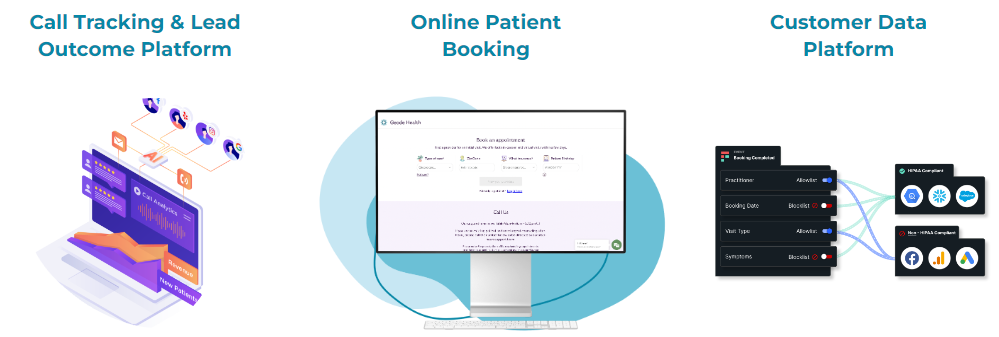The economic climate remains uncertain across sectors, including in healthcare. This uncertainty has left the C-suite with a laser focus on ROI. For healthcare marketers, this means they must demonstrate that every dollar is working overtime.
Table of Contents
Tracking marketing ROI in the healthcare industry, however, is notoriously difficult. One reason is that many healthcare technologies lack interoperability, making it difficult to get the data needed for end-to-end measurement across efforts. Complex brand architectures and M&A can also introduce more complexity into the mix, compounding inconsistency in data management, KPIs, and more. Finally, new HHS guidelines regarding patient data and privacy and the resulting need for HIPAA compliance make all of this much more challenging.
At Cardinal, we often see healthcare groups that want to determine marketing ROI. But the problem is that most are not investing in the technologies that make tracking and measuring possible.
What do healthcare groups need to answer the ROI question? Let’s break it down step by step.
Marketing Tracking Maturity Timeline
To start, it’s essential to understand that there are different levels to tracking marketing performance:
![]()
Form & Call Tracking
The standard approach involves form and call tracking in which conversions are valued equally. When executed manually, form and call tracking can be time-consuming and cumbersome. The better approach involves AI-powered tech, such as Liine and CallBox, which can track call outcomes and send that data back into the ad platforms you use to drive new patients.
Proxies & Passing Back Data
The next step in the evolution of driving better quality leads is setting and optimizing to patient revenue proxies by conversion type. Here’s how it works: if a patient is worth $10,000, 1 in 10 web forms turns into a patient, and 1 in 5 phone calls turns into a patient, then a form is worth $1,000 and a call is worth $2,000. Passing this info to the platform will train it to optimize towards users who will place a call.
Closed-loop Tie Backs
Finally, we have the holy grail of tracking— closed-loop tiebacks, which involves tying back patient acquisition and associated revenue to an ad exposure, keyword, campaign, and channel. As a first step, you assign all site visitors a unique ID. When that user becomes a lead (via form submission or call) you associate all the prior anonymous activity associated with their ID to the user.
When the lead then converts to a patient, you can see how they first came to the website, what their last touchpoint was before becoming a lead, and then send an offline conversion back to marketing platforms in order to optimize against it.
While closed loop is the dream, you don’t have to get there on Day One. It’s best to just get started and do what you can to gain directional insight into performance and marketing ROI. As Lauren Leone puts it,
“You don’t have to have that fully closed loop to start the programs. Get the call tracking in place. Understand, at least a quality signal coming from the people reaching out to you. Are they a new patient? And did they inquire about booking an appointment? That is directionally good enough to get you started.”
Pixel & Conversion Tracking
“Pixel” may sound like an odd word in the context of marketing, but it’s one of the most fundamental parts of understanding ROI. Whether you realize it or not, you’ve likely encountered a pixel’s work during your time online. Here’s an example: You get up and run an online search for a special kind of sleeping bag. Next thing you know, you’re on social media, and an ad for that exact sleeping bag pops up. You can thank a pixel for that.
Marketing pixels, sometimes called “tracking” pixels, are tiny bits of code that allow marketers to gather information about site visitors, parsing everything from what pages they view on your site to the type of ads they like to click on. Conversion pixels are a subset that track completed purchases and goals, allowing marketers to link revenue and sales with certain ads or campaigns.
You can see how pixel and conversion tracking would be helpful in healthcare, right? With pixel and conversion tracking, you can
- Identify where leads and booked appointments are coming from
- the actions patients are taking on your site
- How patients book appointments (via form fill, calls, etc.)
To do all this effectively, your marketing team needs a resource adept with Google Tag Manager that can set up the tags necessary to track events on your website.
Of course, compliance is the elephant in any healthcare marketing room these days. While pixel tracking is under the spotlight by HHS, it can be done in a HIPAA-compliant manner. A CDP (Customer Data Platform) can allow you to de-identify users so that you are tracking and collecting data ethically. (More on that below!)
Core Marketing Technologies Required for End-to-End Measurement

So, which tools should you turn to to make all that magic happen? To solve the ROI challenge, healthcare marketers need to invest in three core technologies:
- Call tracking & lead outcome platforms
- Online scheduling technology &
- Customer data platforms (CDPs)
These tools will allow you to track campaign performance and outcomes so you can accurately measure ROI and optimize performance across your marketing efforts.
Call Tracking & Lead Outcome Platforms
Call tracking and lead outcome platforms are technologies used to track and analyze incoming phone calls as well as form submissions. Powered by AI, they can identify campaign sources, patient sentiment, lead quality, and more.
Our recommended vendors:
Which vendors do we recommend? We like Liine and CallBox, as mentioned above, as well as Patient Prism.
What’s the best way to leverage these tools to understand ROI? Adhere to the following:
- Define your goals: Clearly outline the objectives you want to achieve with call analytics, such as tracking marketing campaign effectiveness, measuring lead generation, or improving call handling and patient experience.
- Conduct a comprehensive audit of your website, listing sites, and all digital platforms where your phone numbers are displayed.
- Stay organized and create trackers to document EVERY practice location, phone number, and implementation status.
- Don’t forget about offline sources, like brochures, billboards, ads, etc. Those phone numbers need to be updated and accounted for.
- Work with a professional when dealing with complex brand architectures and multiple practice locations, as it requires expertise to navigate the intricacies and ensure effective implementation and management across a platform.

Online Scheduling Technology
Healthcare online scheduling technology enables patients to book appointments with healthcare providers conveniently and efficiently through digital platforms. Booking information can be integrated with EHR and PMS platforms, as well as CRMs.
Our recommended vendor for online scheduling? NexHealth. What are the implementation tips we recommend to our clients? The following best practices will help you get the most out of your online scheduling technology:
- Assess your needs regarding scheduling requirements and workflows.
- Determine compatibility and integration capabilities of the scheduling tool with your existing electronic health record (EHR) system, practice management software, or other relevant systems to streamline workflows and data management.
- Develop a conversion tracking plan to capture website and booking events consistently.
One note of caution here: we recommend staying away from ZocDoc. This solution is a “walled garden” of sorts, and you can’t access the information you need from it. Once a user goes to the ZocDoc website to book an appointment, you lose all ability to track what happens.
Customer Data Platform
CDPs are software platforms that collect, integrate, and manage customer data from various sources to create a unified and comprehensive customer profile. They can be used as part of a broader data management strategy to help facilitate HIPAA compliance in healthcare.
Which vendors should you turn to? We recommend Rudderstack and Freshpaint. To implement a CDP solution, we also recommend the following:
- Conduct a data audit to understand existing data sources, systems, and integrations.
- Where is PHI being captured?
- What data do you need to improve marketing campaign effectiveness?
- Where do you want to send it?
- Determine if the CDP platform effectively integrates your data sources and targets.
- Develop a clear plan for how you want to structure and organize your customer data.
Finally, train your team to stay organized and structure data consistently, using the same taxonomy. It’s easy for data to become messy and out of alignment over time.
HIPAA Considerations
Healthcare marketing must always adhere to HIPAA regulations. In the last year, this has become a bit more complicated. A December 2022 bulletin from Health and Human Services upped the stakes on how healthcare organizations handle PHI. This was done, in part, in response to recent FTC complaints against providers in the mental healthcare space.
According to the HHS bulletin:
“Regulated entities are not permitted to use tracking technologies in a manner that would result in impermissible disclosures of PHI to tracking technology vendors or any other violations of the HIPAA Rules.”
As a result of this enhanced scrutiny, every healthcare marketer must now do even more due diligence to ensure that their tech stack is HIPAA-compliant. While this can sound intimidating, there are steps you can take to ensure compliance, as we illustrated in this recent article on the issue.
Integrating with Patient Management and EHR Systems
The ultimate source of patient booking information lives in your EHR/PMS systems. To understand data points like kept appointments, appointment value, customer lifetime value, etc., you must integrate your other solutions with your EHR.
As you evaluate the various solutions we discussed above, keep the following in mind:
- When evaluating vendors, check compatibility with your EHR and what integrations exist
- Assess whether you have the staff and expertise necessary to support integrations
To protect PHI, you can use anonymous or hashed IDs to understand marketing sources and patient outcomes without violating privacy regulations. A CDP makes this easy to implement.
The best approach is to collaborate with your operations, IT, and finance teams to ensure you build the data management processes necessary to determine ROI while remaining compliant. Each of these departments has a role in solving marketing ROI, and a collaborative approach will put you in the best and most effective position overall.
Conclusion
Healthcare organizations can track ROI across marketing initiatives with the right tech stack in place. By adhering to our tips and recommendations, you can build a stack that provides the insights you need while protecting patient privacy.
Want to ensure that you get the most out of your ROI efforts? Work with an agency that knows how to build HIPAA-compliant tech stacks to track marketing performance. Reach out to the team at Cardinal today to get started.

